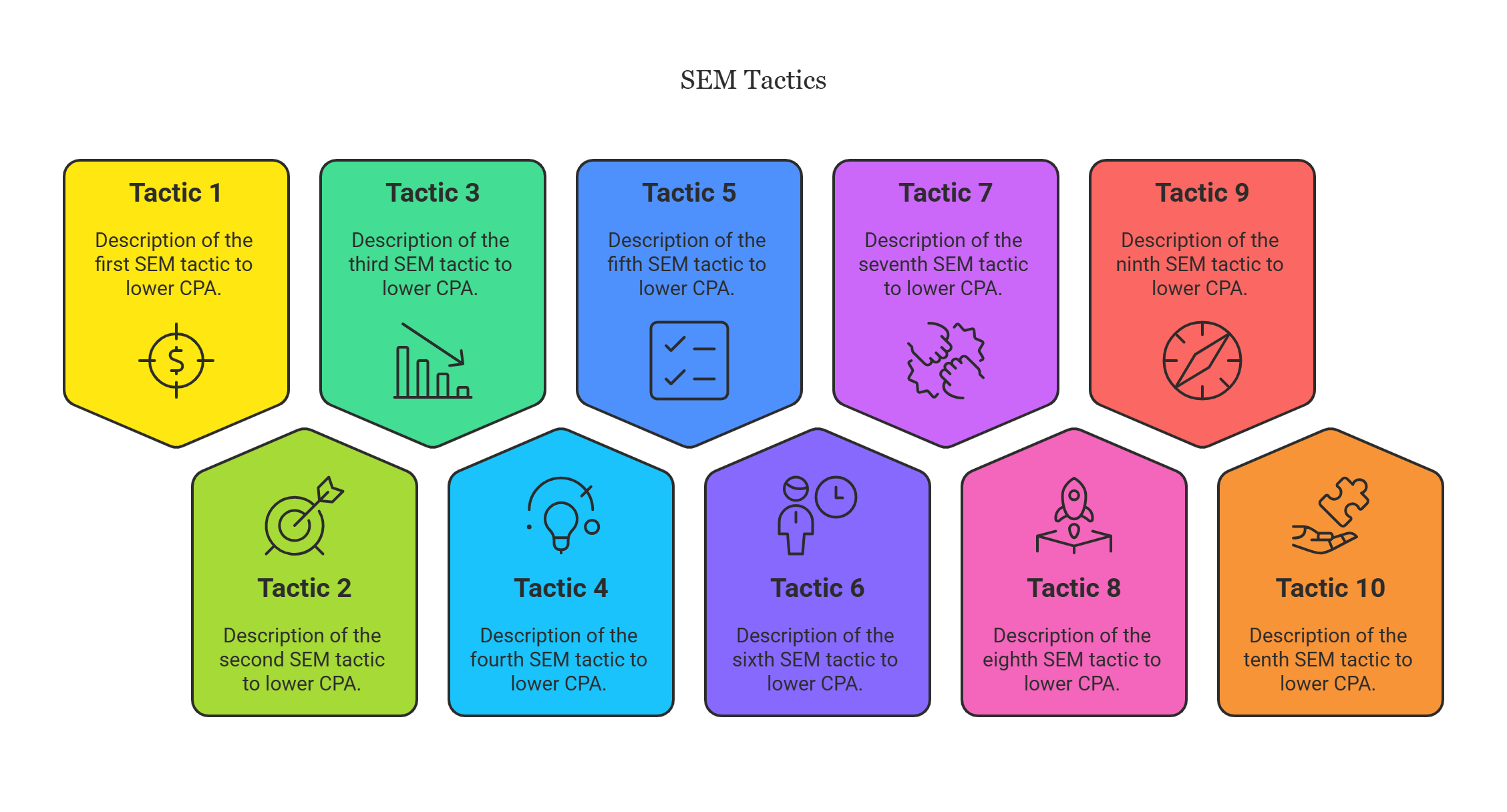I hope you enjoy reading this blog post.
If you want to get more traffic, Contact Us

Click Here - Free 30-Minute Strategy Session
Be quick! FREE spots are almost gone for this Month. Free Quote

Optimising cost-per-acquisition (CPA) in search engine marketing (SEM) is vital for maximising the return on investment (ROI). High CPA metrics can drain marketing budgets, reducing the effectiveness of campaigns. Lowering CPA enables advertisers to acquire more customers without escalating costs, improving long-term profitability.
When SEM campaigns aren’t optimised, they risk wasting money on clicks that fail to convert. Effective CPA management ensures every pound spent contributes to meaningful results. Marketers who focus on refining targeting, ad relevance, and bidding strategies can better control expenses.

Click Here – Free 30-Minute Strategy Session
Be quick! FREE spots are almost gone for this Month
Understanding CPA’s role in campaign performance is essential for any brand aiming for sustainable growth in competitive digital markets.
Creating a well-researched keyword strategy enables businesses to optimise spending while focusing on high-impact terms. By analysing search intent, marketers can identify transactional keywords that align with purchasing decisions.
Steps to create a targeted strategy include:
Refining the strategy ensures resources focus on profitable conversions.
Negative keywords enable advertisers to refine their SEM campaigns by excluding irrelevant queries that could trigger costly but unproductive ad clicks. Using these keywords ensures ads only display to users genuinely interested in the product or service. Identifying search terms that consistently lead to low-quality traffic can dramatically enhance cost-efficiency.
To implement negative keywords effectively, marketers must regularly review search term reports. This helps in identifying patterns of unqualified leads or unrelated searches. Negative keyword lists should be periodically updated to address shifting consumer behaviour and market trends, ensuring campaigns stay optimised over time.
Actively preventing irrelevant traffic through negative keywords leads to better audience targeting, higher ad relevance, and reduced wasted spend.
Optimising ad copy is essential to capture user attention and drive clicks. Strong headlines should immediately address the user’s needs, highlighting unique value propositions. Calls-to-action (CTAs) should be direct and enticing, prompting users to take the desired action. Utilising emotional triggers, such as urgency or curiosity, can further boost engagement. Including relevant keywords in your copy ensures alignment with search intent, improving both visibility and relevance. Leveraging ad extensions, such as sitelinks or call buttons, adds additional opportunities for interaction. A/B testing different variations of copy allows for continual improvement based on performance metrics. Analysing competitor ads provides insight into effective strategies while avoiding repetition.
Geo-targeting allows advertisers to focus efforts on specific geographic areas, tailoring campaigns to locations most likely to convert. By analysing performance data, brands can identify regions generating maximum return on investment and prioritise ad spend accordingly.
Features like location-based keywords, radius targeting, and city-level segmentation enhance campaign relevance. For example, using ad copy customised for local culture or adding location extensions boosts click-through rates.
Geo-targeting is especially vital for businesses with physical stores, enabling ads to focus on nearby customers. Adjustments to bid modifiers based on geographic performance empower advertisers to fine-tune their strategy, optimising cost-per-acquisition without wasting budget on unprofitable locations.
A/B testing allows advertisers to compare two variations of a landing page to determine which performs better in driving conversions. This process involves creating two versions (Version A and Version B) and splitting web traffic between them. Key elements to test include headlines, call-to-action (CTA) buttons, imagery, layout, and colour schemes.
Tools such as Google Optimize or Optimizely facilitate testing by providing actionable insights. By monitoring metrics such as bounce rates, session durations, and conversion rates, marketers can identify winning elements. Regular testing ensures landing pages align with audience preferences. A data-driven approach, coupled with continuous optimisation, can significantly reduce cost-per-acquisition over time.
Remarketing campaigns offer advertisers a powerful way to re-engage users who previously interacted with their website but did not convert. By leveraging cookies, businesses can display tailored ads to these visitors as they browse other platforms or return to search engines. This targeted approach increases brand recall and gently nurtures potential customers through the decision-making journey.
Key considerations include:
Effective implementation balances persistence and subtlety, ensuring a seamless user experience.
To achieve cost efficiency, advertisers must align bidding strategies with their campaign goals. A focus on key performance metrics such as quality score, click-through rate (CTR), and conversion rate is crucial. Using automated bidding tools like Target CPA or Maximise Conversions helps optimise efforts by leveraging real-time data.
Manually refining bids also enhances control. Review performance data regularly and adjust bids based on keyword performance, time of day, and geographical location. Lower bids for underperforming keywords while increasing investment in high-conversion terms.
Implementing bid modifiers allows further customisation, empowering advertisers to allocate budget effectively across devices, audiences, or specific locations.
To optimise any SEM (Search Engine Marketing) campaign, tracking performance metrics is crucial. Marketers should utilise tools like Google Analytics and dedicated advertising dashboards to monitor key indicators such as click-through rates (CTR), quality scores, and bounce rates. Analysing these metrics helps identify trends, pinpoint inefficiencies, and allocate budgets effectively.
Regularly assessing ad performance ensures adjustments can be made in real time. Metrics like cost-per-click (CPC) and conversion rates provide actionable insights into campaign efficiency and ROI. Using heatmaps or user behaviour analytics enhances understanding of audience engagement. Continuous refinement through data-driven decision-making fosters sustained improvement while lowering cost-per-acquisition over time.
To achieve tangible and immediate results in lowering Cost-Per-Acquisition (CPA), it is essential to implement tested and effective strategies.
These steps empower measurable improvements in SEM campaigns quickly.

LEAVE A REPLY